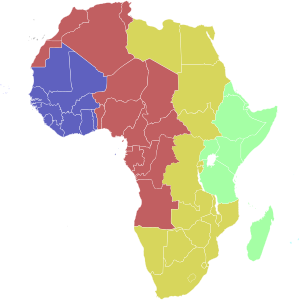Western European Time
This article needs additional citations for verification. (April 2013) |

| Light Blue | Western European Time / Greenwich Mean Time (UTC) |
| Blue | Western European Time / Greenwich Mean Time (UTC) |
| Western European Summer Time / British Summer Time / Irish Standard Time (UTC+1) | |
| Red | Central European Time (UTC+1) |
| Central European Summer Time (UTC+2) | |
| Yellow | Eastern European Time / Kaliningrad Time (UTC+2) |
| Ochre | Eastern European Time (UTC+2) |
| Eastern European Summer Time (UTC+3) | |
| Green | Moscow Time / Turkey Time (UTC+3) |
| Turquoise | Armenia Time / Azerbaijan Time / Georgia Time / Samara Time (UTC+4) |
▉▉▉ Dark colours: Summer time observed

| Light Blue | Cape Verde Time[a] (UTC−1) |
| Blue | Greenwich Mean Time (UTC) |
| Red | (UTC+1) |
| Ochre | (UTC+2) |
| Green | East Africa Time (UTC+3) |
| Turquoise | (UTC+4) |
b Mauritius and the Seychelles are to the east and north-east of Madagascar respectively.
Western European Time (WET, UTC±00:00) is a time zone covering parts of western and northwestern Europe. The following countries and regions use WET in winter months:
- Canary Islands, since 1946 (rest of Spain is CET, UTC+1)
- Faroe Islands, since 1908
- North Eastern Greenland (Danmarkshavn and surrounding area)
- Iceland, since 1968
- Portugal, since 1912 with pauses (except Azores, UTC−1)[1]
- Madeira Islands, since 1912 with pauses[2]
- Ireland, since 1916 (legally known as Greenwich Mean Time) except between 1968 and 1971
- United Kingdom and Crown dependencies, since 1847 in England, Scotland, Wales, the Channel Islands, and the Isle of Man, and since 1916 in Northern Ireland (legally known as Greenwich Mean Time), with pauses[3][4][5]
- Morocco, since 2008
All the above countries except Iceland implement daylight saving time in summer, switching to Western European Summer Time (WEST, UTC+1), which is one hour ahead of WET. WEST is called British Summer Time in the UK and is officially known as Irish Standard Time in Ireland.
The nominal span of the time zone is 7.5°E to 7.5°W (0° ± 7.5°), but the WET zone does not include the Netherlands, Belgium, Luxembourg, France, Gibraltar or Spain which use Central European Time (CET), although these are mostly (France) or completely (the rest) west of 7.5°E. Conversely, Iceland and eastern Greenland are included although both are west of 7.5°W. In September 2013, a Spanish parliamentary committee recommended switching to WET, a move being considered by MPs.[6][7][8]
Historical uses
A slight variation of this time zone, based until 1911 on the Paris Meridian, was used in:
- Andorra: 1901–46
- Belgium: 1892–1914 and 1919–1940
- France: 1911–1940 and 1944–1945
- Gibraltar: 1880–1957
- Luxembourg: 1918–1940
- Monaco: 1911–1945
Until the Second World War, France used WET. However, the German occupation switched France to German time, and it has remained in CET since then.[9] Two other occupied territories, Belgium and the Netherlands, did the same, and Spain also switched to CET in solidarity with Germany under the orders of General Franco.
In the United Kingdom, from 1940 to 1945 British Summer Time (BST=CET) was used in winters, and from 1941 to 1945 and again in 1947, British Double Summer Time (BDST=CEST) was used in summers. Between 18 February 1968 and 31 October 1971, BST was used all year round.
In Ireland, from 1940 to 1946 Irish Summer Time (IST=CET) was used all year round, with no 'double' summer time akin to that in the United Kingdom. Between 18 February 1968 and 31 October 1971, Irish Standard Time was used all year round.
In Portugal, CET was used in the mainland from 1966 to 1976 and from 1992 to 1996. The autonomous region of the Azores used WET from 1992 to 1993.[10][11][12]
Anomalies

| Colour | Legal time vs local mean time |
|---|---|
| 1 h ± 30 m behind | |
| 0 h ± 30 m | |
| 1 h ± 30 m ahead | |
| 2 h ± 30 m ahead | |
| 3 h ± 30 m ahead |
Areas located outside UTC longitudes using Western European Time
Located west of 7°30′ W ("physical" UTC-1)
Areas located within UTC longitudes using other time zones
These areas are located between 7°30′ W and 22°30′ W ("physical" UTC)
Areas using UTC+1: See Central European Time
References
- ^ "Time Zones of Portugal". Statoids. Retrieved 18 October 2011.
- ^ "Time Zones of Portugal". Statoids. Retrieved 18 October 2011.
- ^ "Lighter nights would keep youngsters fitter and safer, say doctors". Western Mail. Cardiff. 27 June 2005.
- ^ David Ennals "British Standard Times Bill [Lords",] Hansard, House of Commons Debate, 23 January 1968, vol 757 cc290-366, 290–92
- ^ "British Standard Time", Hansard (HC), 2 December 1970, vol 807 cc1331-422
- ^ "Spain considers time zone change to boost productivity". BBC News. 27 September 2013.
- ^ Hamilos, Paul (26 September 2013). "Adiós, siesta? Spain considers ending Franco's change to working hours". The Guardian (London).
- ^ Dewey, Caitlin (26 September 2013). "Spaniards are less productive, constantly tired because Spain is in the wrong time zone". The Washington Post.
- ^ Poulle, Yvonne (1999). "La France à l'heure allemande" (PDF). Bibliothèque de l'école des chartes. 157 (2): 493–502. doi:10.3406/bec.1999.450989. Retrieved 11 January 2012.
- ^ Decreto Legislativo Regional n.º 29/92/A (23-12-1992) (in Portuguese), Diário da República (Diary of the Republic) – 1st Series - A, nr. 295, p. 5932-(2), 23 December 1992. Retrieved 11 January 2014
- ^ Decreto Legislativo Regional n.º 8/93/A (26-03-1993) (in Portuguese), Diário da República (Diary of the Republic) – 1st Series - A, nr. 72, p. 1496-(272), 23 March 1993. Retrieved 11 January 2014
- ^ Decreto Legislativo Regional n.º 9/93/A (15-07-1993) (in Portuguese), Diário da República (Diary of the Republic) – 1st Series - A, nr. 164, p. 3845-3846, 15 July 1993. Retrieved 11 January 2014
